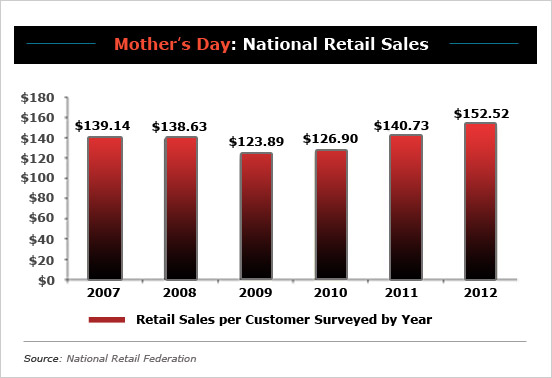Flowers or candy? A luxe spa visit or an American Express gift card? For millions of Americans, the clock is ticking on what to get Mom for Mother's Day.
One thing is clear: In today’s economy, Americans will spend more on Mom than they have in recent years – $18.6 billion nationally, according to the National Retail Federation’s consumer spending survey done last month.
That’s about $152 per person this year – up $12 over last year. This continues an upward spending trend since 2009, in spite of high gas prices and economic uncertainty.
WHAT'S IN THE SHOPPING CART
Two thirds of consumers, or 66.4 percent, will buy $2.2 billion worth of flowers, while nearly one third will spend $1.6 billion on clothing and accessories, according to the NRF survey. Those who buy electronics (12.7 percent) will shell out $1.6 billion on tablets, digital cameras and more, while over half of all spenders (54.3 percent) will spring for a nice dinner or brunch, at $3.4 billion.
Consumers will also shell out about $1.8 billion on gift cards and $1.3 billion on personal services such as day-spa trips.
INSERT CHART HERE
Mother’s Day is the third-largest card-sending holiday in the U.S., with 133 million cards exchanged annually, according to Hallmark. The privately held company, based in Kansas City, Mo., is offering nearly 1,000 different cards for moms this year, and says that, on average, consumers buy 2.8 Mother’s Day cards each year. About 65 percent of those purchases occur five days before the holiday.
BRICKS AND MORTAR
More than one third of gift buyers will shop at a department store, the most in the NRF’s survey history. Other shoppers will head to discount stores (30.2 percent); specialty stores including jewelers, florists and electronics stores (36.3 percent); and specialty clothing stores (8.2 percent).
One quarter of shoppers, meanwhile, will buy gifts online – up from 21.5 percent last year.

But despite the jump in expected spending, experts also say that many Americans are still in the market for deals in 2012, carefully eyeing where and how to shave costs – using discounts, coupons and other methods.
RELATED: 12 Things That Will Get Cheaper in 2012
For retailers Mother’s Day is certainly a cash cow: It’s the fourth most lucrative holiday after Christmas, Thanksgiving and Valentine’s Day. Martha Studstill, owner of Uptown Gifts in downtown Columbia, has been busy all week selling Mother’s Day gifts. “We do a lot of personalizations, so people know they have to shop a little earlier to get those kinds of things going,” Studstill told The Chicago Tribune. “They’ve been shopping last week and this week, and we hope they’ll shop a lot more before the weekend.”
Bathrobes, shower wraps and fleece blankets, which average between $35 and $45 and are normally bought for graduation, have been hot choices this year for Mother’s Day, Studstill added.
SPENDING OVERLOAD?
Judy Coffey, a mother of three grown daughters from Evanston, Ill., laughed when she heard the Mother’s Day spending figures. “I don’t know where they get that kind of money – probably from their mother!” she said.
A human resources consultant, Coffey said a thoughtful card in the mail would really make her happy, since that wouldn’t impose a financial burden on her daughters who live out of town. “It’s much better for my husband and me if our kids don’t get themselves into a situation where they will have to come back to us for financial support. I’d much rather they put [their money] into a savings account or toward increasing their 401(k). We’ve got everything we need. We aren’t looking for material things from our kids,” she said.
RELATED: What Are Stay-at-Home Moms Really Worth?
Jane Adams, a psychologist and expert on parent- and adult-child relationships, says, “I think that for those who have the money, it’s a way of showing how successful they are to give their mother something extravagant. But regardless of earnings, when it boils down to it, parents rarely measure their relationships with their kids or their kids’ success levels based on how much they spend.”
The holiday’s roots had nothing to do with feeding the economy: It all began in 1905 when Anna Jarvis, a Philadelphia resident, vowed at her mother’s gravesite to honor her mother’s lifelong wish that a day to recognize mothers be established. She gave up her job as a teacher to lead a letter-writing campaign and lobbied for almost ten years for churches to hold Mother’s Day services, until 1914, when Congress passed a law declaring the second Sunday in May Mother’s Day.
A thoughtful day is exactly what MaryAnne Smith, a mother of two from central New Jersey, looks forward to. “Just spending time with my kids on Mother’s Day means a lot,” she says. “I really don’t like to receive gifts, but when my son and daughter buy me a card, I take to heart what the card says, mostly because I know they have a hard time expressing how they feel about me. My favorite thing for Mom’s day is a card that speaks from my kids’ hearts.”
This article is updated from an earlier version that appeared in The Fiscal Times.



